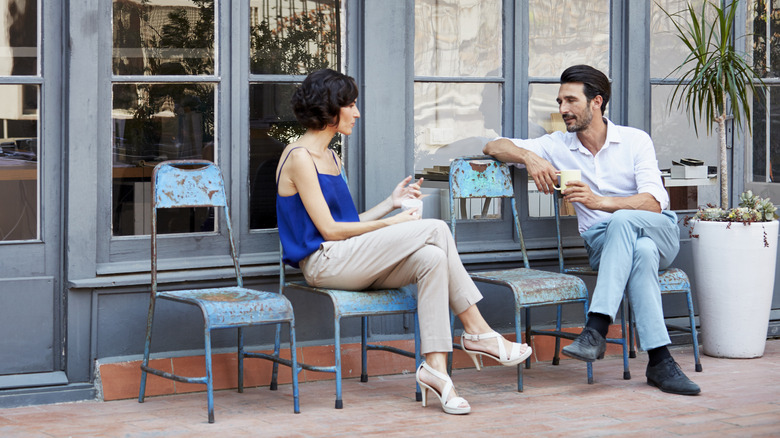The Unexpected Body Gesture That's Actually Quite Offensive In Different Countries
For many of us, crossing legs is just comfortable. You rest one leg on the other, knee over knee, locking the two limbs in place. They fit together so well, as if they were designed for stacking. One foot is planted firmly on the ground, while the other dangles nonchalantly. Or you can do the "loose" leg-crossing, where you bend your leg at a 45-degree angle and set your ankle on your kneecap. There, isn't that nice? Balanced and casual, you lean into your backrest like you invented the concept of sitting. For many women who grew up with skirts and dresses, this has long been considered the proper way to sit; for men, the posture prevents slouches and "man-spreading." For any gender identity, it's just pleasant.
But not everyone likes crossed legs, and in some cultures, it's considered rude. In Japan, people are strongly discouraged from crossing legs while sitting in chairs, no matter what gender they are. People are supposed to sit with legs next to each other, knees close or touching. Crossing legs is just one of the many things that conscientious tourists should never do when visiting Japan.
Why would the Japanese be so averse to this position? Part of it is the historical absence of chairs; Japanese people frequently sat or knelt on the floor, which was traditionally cushioned with tatami mats. Even today, a "tatami room" is a common space in Japanese homes, where all activity — working, drinking tea, socializing — takes place low to the ground. Here, people may cross their legs, but in the criss-cross manner that Americans know from grade school. Then there's the other reason crossing legs is a no-go: It's offensive to show the bottoms of your shoes.
Never show the soles of your shoes in parts of Asia
Aversion to seeing soles isn't unique to the Japanese; travelers should plan to conceal the bottoms of their footwear across East Asia. Removing shoes at a threshold is the one rule you should follow when entering a home in Japan, and this holds true in China, Korea, and Southeast Asia as well. In the Middle East, strangers often assess each other by the condition of their shoes; one of the gravest insults is to throw a shoe at someone, a tradition that dates back to ancient times.
Crossing legs doesn't necessarily reveal your sole, but it's risky, and most of these cultures have built their sitting poses around that possibility. Like eating with your left hand in India or this standing gesture that quietly offends from Tokyo to Paris, crossing legs is something to avoid across the Asian continent. If you usually prefer to sit like this, condition yourself in the days ahead of your journey to sit in a socially acceptable manner. Culturally, this should give you a leg up.

